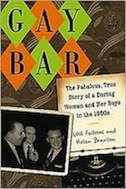 Gay Bar: The Fabulous, True Story of a Daring Woman and Her Boys in the 1950s
Gay Bar: The Fabulous, True Story of a Daring Woman and Her Boys in the 1950s
by Will Fellows and Helen Branson
University of Wisconsin Press. 186 pages, $26.95
GAY BAR is a queer little book by a queer little woman who, yes, owned a gay bar on Melrose Avenue in Los Angeles in the 1950’s. The book is a rediscovery, having been published more than half a century ago (in 1957) by a company owned by the early gay rights activist Hal Call. Now, writer-historian Will Fellows has repackaged the book, with a new introduction and copious notes and commentary. Fellows knew of the book but had never seen it before commencing his research. He found it at the Quatrefoil Library in St. Paul, Minnesota. He then traveled to Los Angeles to use the myriad resources at the ONE National Gay and Lesbian Archives, the world’s oldest, largest glbt archive, to find material to supplement the rather slim volume originally written by Helen Branson.
So what is in this little gem of a time capsule? Well, it’s an introduction to a world hardly recognizable to us today—or is it? The bar was small, a little dingy, but very respectable, on Helen’s insistence. She knew her “boys”—as she always called them and to whom the book is dedicated—by name, and she protected them. But if they misbehaved, she banished them. The lapd was a notoriously homophobic institution well into the 1970’s. Helen seems to have had little trouble from them, but she did protect the boys from the vice squad by giving the cold shoulder (and a warm glass) to any man who came in alone for the first time. Usually, Helen’s boys knew to introduce their new friends directly to her. The regular would act as a kind of sponsor to make sure the new guy was legit, not a pretty boy actor working for vice, which was routine practice—and good employment for wannabe actors in those days.
When the book was first published, Dr. Blanche Baker, an early supporter of the cause, provided an “expert” introduction in which she asserted that “there are countless homophiles who are well-adjusted members of society.” Baker also said: “I doubt if the homosexual can be accepted in society until he learns to clear himself from the hate, prejudice and intolerance within himself.”
Readers of today may find themselves shuddering a little at the attitudes they find in the book, though I don’t think they’ll be too surprised. The “cult of masculinity” of 1950’s America was front and center in Helen’s establishment; it is debated in the commentary chapters among readers of One magazine. Helen and her boys did not appreciate “flaming” behavior; there was a non-flamboyant code of conduct in the bar, but there was also plenty of dishing and camping. Helen writes that “I have not touched the problem of the obvious homosexual. He is in the minority. … I do not want this type in the bar. I am rude to them, watch them closely for any infraction of my arbitrary rules, and they soon leave. … They are a menace to my business.”
Fellows offers a lot of information about the “issues of self-presentation,” which he says “loomed large for many gay men” in those days—and perhaps today. He discusses a cover story in the Mattachine Review (from October, 1958) on “The Homosexual Swish”—a person, not a gesture: “homophiles need to tolerate their own kind,” argued the author. Fellows quotes angry letter-writers ranting about “the stupid, frivolous side of homosexuality” and men who “dress in the God-awfullest attire that only a queer could assemble.” These comments show the self-loathing of sixty years ago, and they also show the stakes (personal as well as public) in relating behavior to visibility and to tolerance.
One surprise encounter at the end of the book: Helen gets interviewed by Dr. Alfred Kinsey. She tells a story that sounds much like the interviews we see in the film Kinsey. The good doctor is a bit skeptical of some of Helen’s answers; they don’t sound like things other gay bar owners have told him. However, some of Helen’s boys were part of a Mattachine group that met with Kinsey. They assured him that what Helen told him about her bar and her boys was true. According to them, Kinsey said, “If that woman runs that bar the way she says she does and the way you say she does, then it is the only bar in the United States that is run that way.” Helen appreciated the compliment; the reader appreciates Kinsey’s expert opinion.
As a bartender, Helen was a good listener, a counselor, and a mediator. She told interesting, amusing, sometimes heartbreaking anecdotes about jobs lost or found, lovers coming and going, and boys in love or in trouble. While parts of the book seem apocryphal, there is plenty of specificity. Helen’s boys are real people with real struggles. Their stories are worth reading; they offer a glimpse of “ancient history” that isn’t, as well we know, all that ancient after all.
________________________________________________________
Chris Freeman is co-author of Fine On Acting and co-editor of Love, West Hollywood: Reflections of Los Angeles. He teaches at the University of Southern California.





